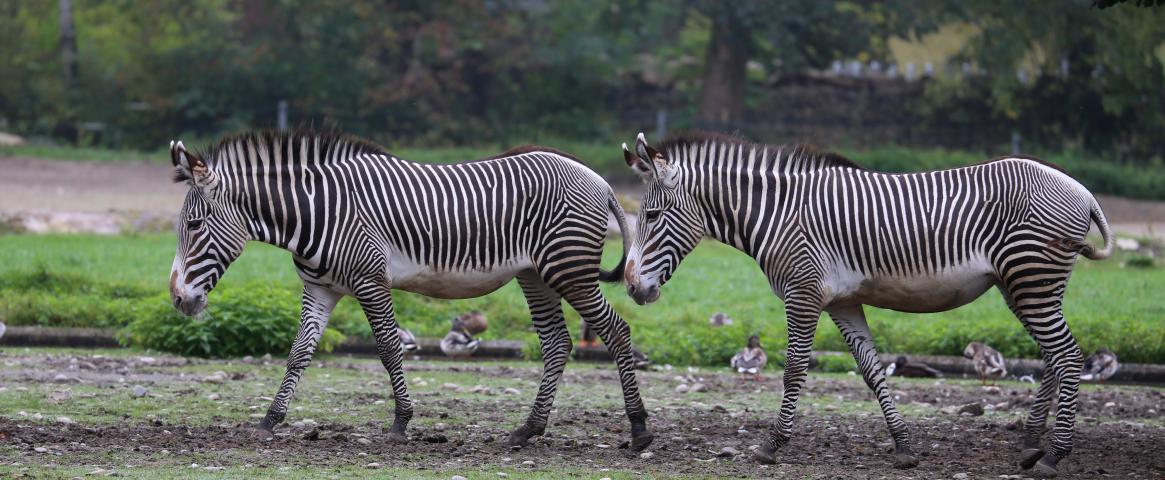By Shweata N. Hegde. Mentored and edited by Chad Boutin.
In 2016, hundreds of volunteers in Kenya – school kids, park rangers, scientists, and tourists – took part in a two-day event called Great Grevy's Rally to help save the endangered Grevy’s Zebra. The volunteers were helping take the first step in preserving any species: finding out exactly how many of these zebras currently remain. They drove around the grasslands and clicked photos of Grevy's Zebras, but not for their scrapbooks. The photos were for their partner in the mission: an artificial intelligence (AI) technology that can tell individuals apart and determine the population size.
The Grevy’s Zebra is one of more than 40,000 animal species for which we know little about the population trend. ”We don't know how well they are doing, whether they are increasing, decreasing or stable,” said Tanya Berger-Wolf, the director of the Translational Data Analytics Institute, at a session on biodiversity conservation through crowdsourced science at the 2022 AAAS meeting. Conventional methods of surveying animal populations are labor- and resource-intensive, inaccurate and, most importantly, take a lot of time. We urgently need more accurate data to inform policies that will help save species from disappearing.
The AI technology is part of a platform called Wildbook, created by the nonprofit Wild Me. Here’s how the platform works: Humans upload animal images and associated data (like the date and place the photo was taken) to Wildbook. Based on an animal’s body patterns, such as the stripes on a zebra, the AI identifies not only which species the animals in the pictures belong to, but "who" each individual is. Once we know each zebra’s identity, we can tell how many there are at a given place and time – and how well they are doing.
With AI as our partner, we are not limited to surveying zebras alone. The Wildbook team has developed seven algorithms that they can use to survey other animals with unique body patterns. “We have Wildbooks for more than 60 species from marine to terrestrial: turtles and whales; and skunks and leopards,” said Berger-Wolf, who is also a co-founder of Wildbook.
The 2016 Rally revealed that there were 2,350 (give or take 93) Grevy’s Zebras left – an 85-90% reduction from an estimated 13,700 three decades ago. They repeated the Rally in 2018, which drew more volunteers and, importantly, policymakers in the Kenyan government. After the numbers were out, the policymakers put together an endangered species management plan to protect the approximately 2,812 zebras that AI and humans together identified that year.
Daniel Rubenstein, a behavioral ecologist from Princeton University and the co-organizer of the session, pointed out the importance of partnerships in conserving species – not only partnerships among humans, but also between humans and machines. The collaboration between AI and humans allowed the Wildbook team to go from the first step of surveying the zebra population to getting the government on board with implementing plans to conserve them. “The Kenyan government only accepted the numbers because it was a partnership,” said Rubenstein, who has been working on the Grevy’s Zebra for decades.
The human-AI partnership, Berger-Wolf agrees, “to me is not only nice to have, [but] is critical to have in the first place to enable trust in the AI solutions.”
Coming up with useful AI technology for conservation involves collaboration between biologists and computer scientists, as well as interested citizen scientists. Wildbook enables collaborations between researchers and citizens by acting as a secure, central place to share animal image data. The Wildbook for Sharks, for example, has contributions from 300 researchers and volunteers and more than 9,000 citizen scientists.
Like many issues that we are trying to solve with the aid of AI, neither humans nor machines can solve the problem by themselves. It is the collaboration between them that makes the difference. People – yourself included – can help the Wildbook effort by contributing to their growing collection of endangered animals’ image data. Or, because the AI software is open source, you could even help make the AI a better collaborator. The partnership between humans and AI technology, as Rubenstein said, “is really making the world small when these problems are so huge.”
Shweata N. Hegde is a 3rd-year undergrad from the Regional Institute of Education in Mysore, India. She co-hosts a science podcast called IndiaAsksWhy. She is also a novice programmer working with an open science research team to develop tools to automatically "read" the scientific literature. Follow her on Twitter @shweataHegde or email her at shweata.hegde@gmail.com.
Image: Can you tell these Grevy’s Zebras apart? Artificial intelligence can – and it’s helping its human partners with saving endangered species. Credit: Rufus46, CC BY-SA 3.0, via Wikimedia Commons




